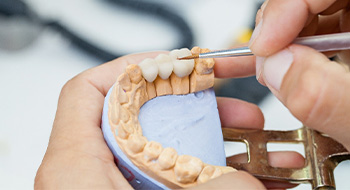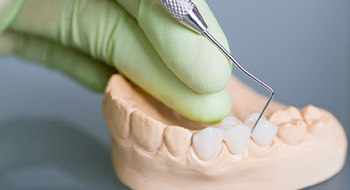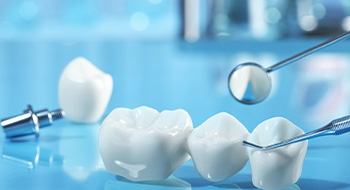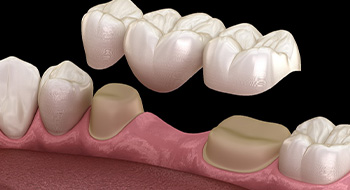Dental Bridges – Daytona Beach, FL
Complete Your Smile with a Dental Bridge
 Bridges are a fairly common sight around Daytona Beach; getting around town would be much more difficult without them! The dental bridges that we offer here in our office work similarly, and the job they do is incredibly important. They bridge the gap in your smile so you can smile confidently, speak clearly, and chew a variety of your favorite foods. To learn more about dental bridges, or to schedule an appointment with our office to see if one can be used to replace your missing teeth, don’t hesitate to contact us today!
Bridges are a fairly common sight around Daytona Beach; getting around town would be much more difficult without them! The dental bridges that we offer here in our office work similarly, and the job they do is incredibly important. They bridge the gap in your smile so you can smile confidently, speak clearly, and chew a variety of your favorite foods. To learn more about dental bridges, or to schedule an appointment with our office to see if one can be used to replace your missing teeth, don’t hesitate to contact us today!
Why Choose Indigo Dental of Daytona Beach for Dental Bridges?
- Friendly Dentist with Several Years of Experience
- Beautiful, High-Quality Materials Used
- Implant Dental Bridges Available
What is a Dental Bridge?

Dental bridges are restorations used to close the gap left behind by a missing tooth or multiple missing teeth. A bridge permanently anchors the artificial teeth, called pontics, to the adjacent, existing teeth on either side of the gap. In some cases, dental implants may also be used to secure bridges.
Bridges look natural, feel comfortable, and restore oral functionality – this is thanks to the detailed impressions and careful considerations taken by Dr. Lloyd and his team. You can rest assured that after you’ve received yours, you’ll hardly notice or feel a difference between it and your natural teeth!
Types of Dental Bridges

The only way to determine which type of bridge is suitable for your needs is to come to visit Dr. Lloyd for a consultation; he’ll be able to quickly examine your situation, review your medical history, and determine if a bridge can be used to restore your grin. We’re proud to offer two different types of bridges here in our Daytona Beach office – here’s a closer look at each of them:
Traditional Dental Bridges

This is often the go-to option for patients missing one, two, or more teeth in a row. First, we’ll place a crown on either side of the gap and then we can “bridge” the space with pontics. While this method does require a slight alteration of your existing adjacent teeth, in addition to them needing to be healthy, it ensures lasting success and a normal-looking appearance.
Implant Bridges
Implant bridges are different than their traditional counterparts; rather than relying on crowns placed on healthy adjacent teeth for support, they rely on dental implants placed directly into the jawbone. Due to the impressive level of stability provided by the implant posts, your restoration will have a much longer lifespan, feel more natural, and return more of your biting power. It also doesn’t require your existing teeth to be altered. However, the process for receiving implants is lengthier, and patients must also meet specific dental health requirements.
The Benefits of Getting a Dental Bridge

When you receive a dental bridge, you’re not just restoring the gap in your grin – you’re also gaining access to numerous life-changing benefits, including:
- Bridges are fully customized for your smile, meaning they’ll look and feel completely natural.
- Bridges can replace one, two, or more missing teeth in a row, making them quite versatile.
- They allow you to speak clearly and bite and chew normally, meaning your day-to-day will become noticeably easier.
- They actually help to prevent dental drift, which is the misalignment of remaining teeth following tooth loss.
- They’re remarkably easy to care for and can last for 10+ years under ideal circumstances.
Dental Bridges FAQs
How Many Teeth Can a Dental Bridge Replace?
Dental bridges in Daytona Beach have been used for generations to treat consecutive tooth loss. A traditional fixed bridge can replace 1 or more lost teeth in a row. However, most dentists only recommend replacing 1-3 teeth with a bridge because longer restorations can be less stable. If you're missing several teeth in a row, your dentist may recommend dental implants or a partial denture as an alternative.
Are Dental Implants Cheaper Than a Bridge?
Dental implants differ from a bridge because they replace both the tooth roots and the crowns for results that look and feel natural. Initially, you may pay more out-of-pocket for dental implants, but you'll save money down the road. A traditional bridge only lasts for a few years before needing to be replaced, but dental implants are proven to last for 30 years or longer. With over a 95% success rate, you'll never have to budget for replacements. Dental implants offer priceless benefits that just aren't possible using a traditional fixed bridge.
Does Getting a Dental Bridge Hurt?
Your dentist in Daytona Beach, Dr. David R. Lloyd, will always keep your comfort as his top priority. He may administer numbing medication when prepping your teeth for your bridge. You won't feel any pain during the process. However, it's normal to experience temporary tenderness after the effects of any numbing medications wear off. It will dissipate in a couple of days. You can manage any discomfort with an over-the-counter pain reliever and eating soft foods.
How Long Do Dental Bridges Last?
A traditional fixed bridge can last for 5 to 15 years before needing to be replaced. Various factors affect their lifespan, like the materials used and the location of the restoration. Back teeth undergo more wear and tear naturally. Bridges used to replace molars may need replacing more often than those used for front teeth. Choosing high-quality materials will ensure your bridge lasts its longest. You can get the most from your investment with good oral hygiene at home and regular dental care. Moderate your consumption of hard or chewy foods. Break any bad habits that may damage your restoration, like grinding your teeth or crunching ice.
Can I Use My Dental Insurance for a Bridge?
Most dental insurance will cover some of the expenses, like your consultation, diagnostic services, or preparatory procedures. After meeting your annual deductible, your dental insurance can pay 50% to 80% of the cost until reaching your annual limit. We will work on your behalf of your dental insurance to maximize your coverage. A member of our office will review your payment options for any out-of-pocket expenses, like a monthly payment plan using CareCredit.
